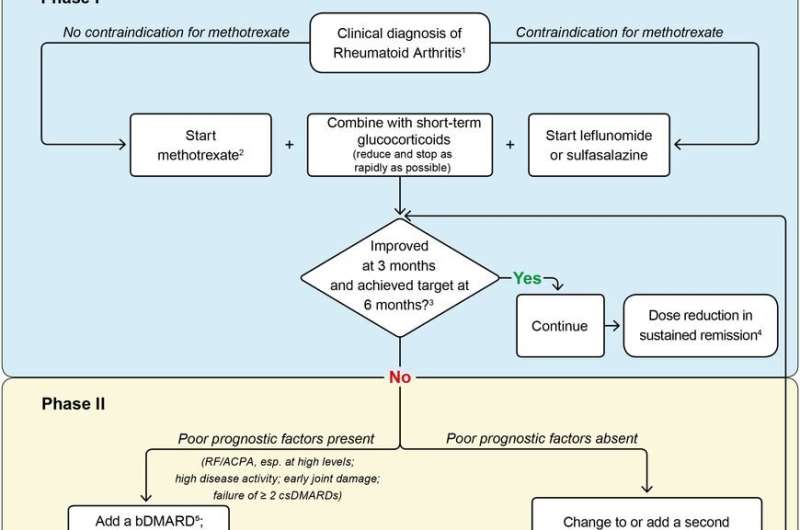
Since their first publication in 2010, the EULAR recommendations for the use of disease-modifying anti-rheumatic treatments (DMARDs) in people with rheumatoid arthritis (RA) have become a most important publication in the field, and their updates are relied upon by many healthcare professionals, professional organizations and other stakeholders to offer an up-to-date and robust analysis on an optimal approach to the application of available treatment options in clinical practice.
The recommendations were last updated in 2019, and there have been no new drug classes released since then; however, two key factors warranted revisiting this fifth version of the document
Firstly, in early 2022 a randomized, controlled clinical trial in RA patients selected for various risk factors showed a higher rate of major cardiovascular events and malignancies in those receiving tofacitinib, a Janus kinase inhibitor (JAKi) compared to tumor necrosis factor inhibitors; indeed, already in 2021 the United States Food and Drug Administration (FDA) released a warning on these risks.
In addition, the 2021 update of the RA management guidelines from the American College of Rheumatology (ACR), discouraged the use of glucocorticoids, reasoning that the toxicity outweighs the benefits.
The updated EULAR recommendations were developed by a multidisciplinary task force of rheumatologists, other health professionals, and patient research partners, including infectious disease and epidemiology specialists. The information is based on evidence collected from three systematic reviews across efficacy and safety of both DMARDs and glucocorticoids.
The recommendations were already presented at the EULAR Congress in June 2022 (in Copenhagen) and the full paper which includes all details of the discussion process for every item is now being published in the Annals of the Rheumatic Diseases. The recommendations include 5 overarching principles and 11 recommendations on the use of DMARDs, including conventional synthetic, biologic, and targeted synthetic agents, as well as glucocorticoids.
Guidance on monotherapy, combination therapy, treat-to-target, and tapering strategies is also provided. The general principles say that treatment of RA patients should aim at the best care and must be based on a shared decision between the patient and the rheumatologist—who is the person who should primarily care for people with RA.
Treatment decisions are based on disease activity, safety issues and other patient factors, such as comorbidities and progression of structural damage. But RA also incurs high individual, medical and societal costs, all of which should be considered in its management. The principles also highlight that patients require access to multiple drugs with different modes of action to address the heterogeneity of their disease, and they may require multiple successive therapies throughout life.
The individual recommendations outline that DMARD treatment should be started as soon as possible after the RA diagnosis is made, with an aim of reaching sustained remission or low disease activity. The core recommendation for initial treatment with methotrexate plus glucocorticoids is retained from earlier versions.
For people who have an insufficient response to this therapy within 3 (significant improvement) to 6 (target attainment) months, further lines of treatment should be based on stratification according to individual risk factors. This requires sufficiently frequent monitoring, which should be performed at least every 3 months in people with active disease. Importantly, for people who achieve sustained remission, DMARDs may be tapered but should not be stopped.
One minor change to the previous version is that, in line with the respective SLR results, the group continues to recommend the consideration of the addition of short-term glucocorticoids when initiating or changing csDMARDs, but emphasizes more strongly that they should be tapered and discontinued as quickly as possible.
A newly amended recommendation also outlines that only after glucocorticoids have been discontinued and a patient is in sustained remission, dose reduction of DMARDs may be considered, whether they are conventional synthetic, biologic, or targeted synthetic agents.
Of note, the major change is that JAK inhibitors, while still placed at the same level as bDMARDs, should only be used if risk factors for cardiovascular or malignant diseases have been considered; many of these risk factors are detailed in the respective part of the recommendation.
This means that bDMARDs, irrespective of their mode of action, should be preferred over JAK inhibitors in RA patients with risk factors for malignancy or major adverse cardiovascular events. In this respect, EULAR welcomes the recently published recommendations for JAKi by the European Medicine Agency’s (EMA) Pharmacovigilance Risk Assessment Committee (PRAC), as they are in line with this 2022 update of the EULAR recommendations.
EULAR believe these recommendations are the clearest yet, and represent a logical summary of accumulating evidence. It is hoped that the clearer the information provided in recommendations, the better they may be followed by clinicians.
More information:
Josef S Smolen et al, EULAR recommendations for the management of rheumatoid arthritis with synthetic and biological disease-modifying antirheumatic drugs: 2022 update, Annals of the Rheumatic Diseases (2022). DOI: 10.1136/ard-2022-223356
Journal information:
Annals of the Rheumatic Diseases
Source: Read Full Article
